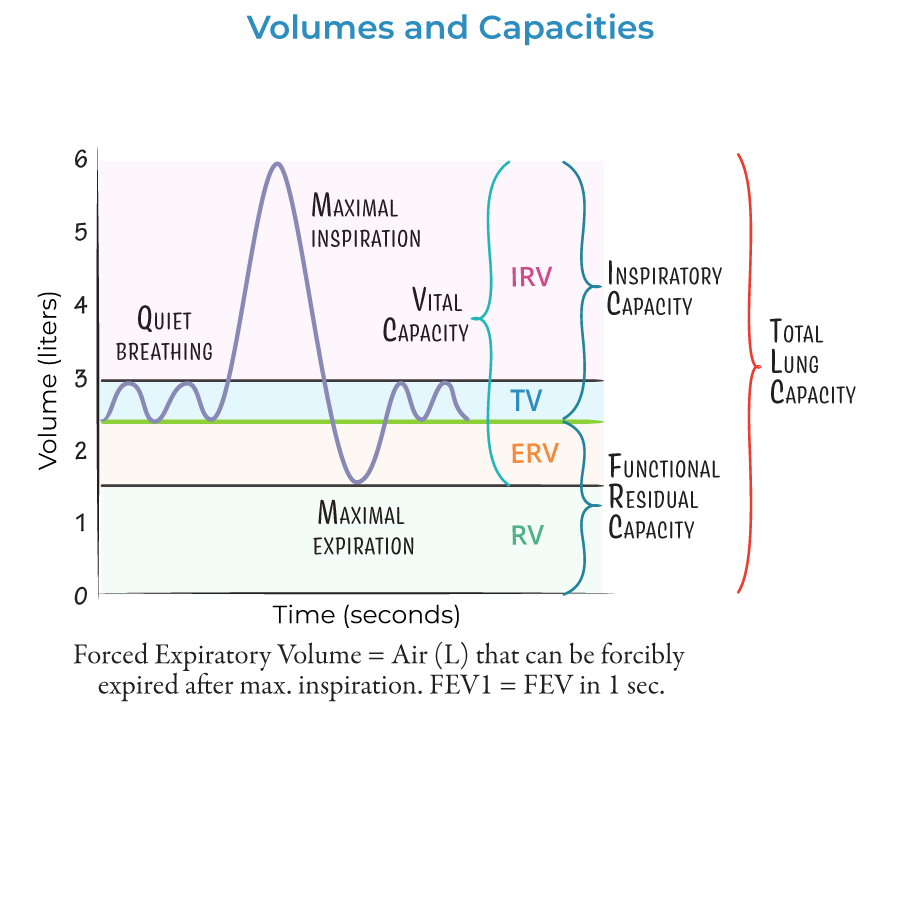Lung Volumes Measure Airflow and Assess Respiratory Health
- Lung volumes refer to the different amounts of air that the lungs can hold during breathing.
- Lung volumes are important measurements that tell us how much air is moving in and out of the lungs during breathing.
- They help us understand how well the lungs are working and can be used to monitor respiratory health.
Main Lung Volumes
- Tidal Volume (TV): The amount of air you breathe in or out during normal, resting breathing (about 500 mL).
- Vital Capacity (VC): The maximum amount of air you can exhale after taking the deepest breath possible. This includes Tidal Volume, Inspiratory Reserve Volume, and Expiratory Reserve Volume (ranges from 3,000–5,000 mL).
- Inspiratory Reserve Volume (IRV): The extra air you can inhale after taking a normal breath (usually 1,900–3,100 mL).
- Expiratory Reserve Volume (ERV): The extra air you can exhale after a normal exhalation (typically 700–1,200 mL).
Why Measure Lung Volumes?
- Understanding lung volumes is critical for several reasons:
- Respiratory Health Monitoring: Deviations from normal lung volumes can signal conditions like asthma, chronic obstructive pulmonary disease (COPD), or restrictive lung disorders.
- Performance Optimization: Athletes monitor lung capacity to maximize oxygen intake and improve endurance.
- Medical Diagnosis: Lung volume measurements aid in identifying and tracking respiratory diseases.
- Treatment Evaluation: They help assess the effectiveness of interventions such as bronchodilators or pulmonary rehabilitation programs.
A spirometry test might reveal reduced vital capacity in a patient with COPD, helping doctors tailor treatment to improve lung function.
How to Measure Lung Volumes Using Spirometry
- Tidal Volume (TV):
- Sit comfortably and breathe normally into the spirometer.
- The average volume per breath is recorded.
- Vital Capacity (VC):
- Take the deepest breath in and exhale as forcefully as possible into the spirometer.
- The total amount of air exhaled is recorded.
- Inspiratory Reserve Volume (IRV):
- Inhale normally, then take a very deep breath.
- The extra air you inhale is your IRV.
- Expiratory Reserve Volume (ERV):
- Exhale normally, then exhale as much air as you can.
- The extra air exhaled is your ERV.
Vital Capacity (VC) is the total volume of air that can be exchanged by the lungs, calculated by adding together Tidal Volume (TV), Inspiratory Reserve Volume (IRV), and Expiratory Reserve Volume (ERV).
VC = TV + IRV + ERV



